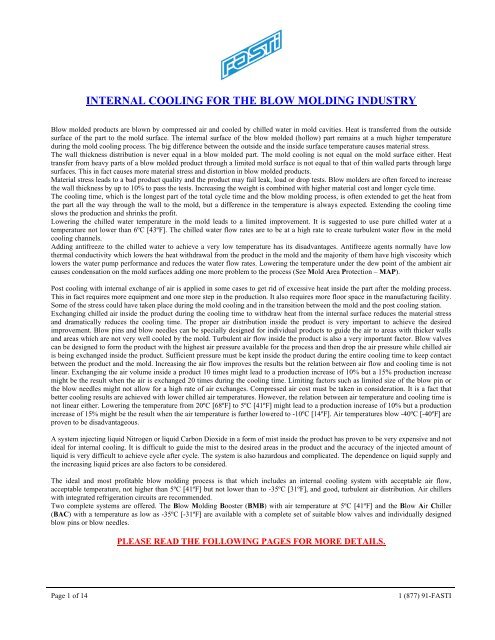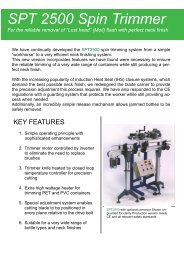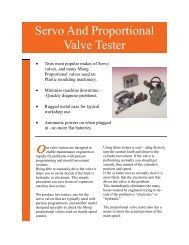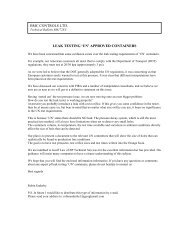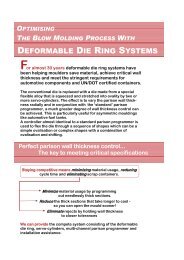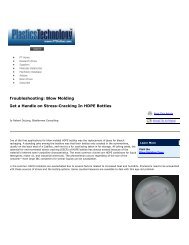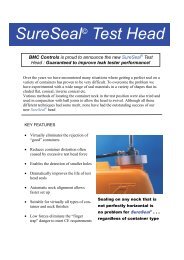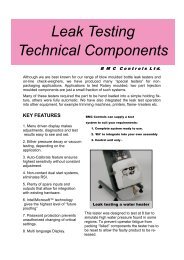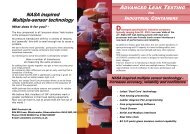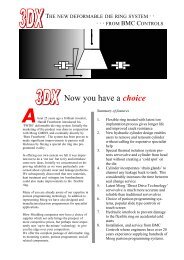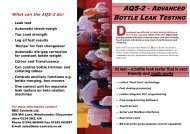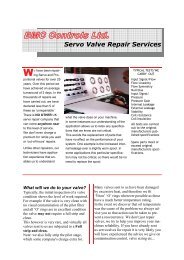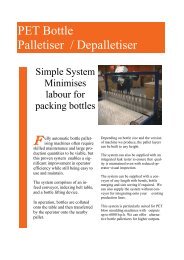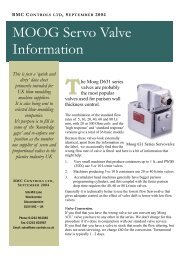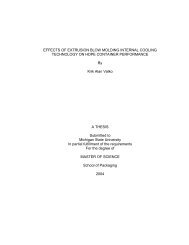internal cooling for the blow molding industry - Blow Moulding Controls
internal cooling for the blow molding industry - Blow Moulding Controls
internal cooling for the blow molding industry - Blow Moulding Controls
You also want an ePaper? Increase the reach of your titles
YUMPU automatically turns print PDFs into web optimized ePapers that Google loves.
INTERNAL COOLING FOR THE BLOW MOLDING INDUSTRY<br />
<strong>Blow</strong> molded products are <strong>blow</strong>n by compressed air and cooled by chilled water in mold cavities. Heat is transferred from <strong>the</strong> outside<br />
surface of <strong>the</strong> part to <strong>the</strong> mold surface. The <strong>internal</strong> surface of <strong>the</strong> <strong>blow</strong> molded (hollow) part remains at a much higher temperature<br />
during <strong>the</strong> mold <strong>cooling</strong> process. The big difference between <strong>the</strong> outside and <strong>the</strong> inside surface temperature causes material stress.<br />
The wall thickness distribution is never equal in a <strong>blow</strong> molded part. The mold <strong>cooling</strong> is not equal on <strong>the</strong> mold surface ei<strong>the</strong>r. Heat<br />
transfer from heavy parts of a <strong>blow</strong> molded product through a limited mold surface is not equal to that of thin walled parts through large<br />
surfaces. This in fact causes more material stress and distortion in <strong>blow</strong> molded products.<br />
Material stress leads to a bad product quality and <strong>the</strong> product may fail leak, load or drop tests. <strong>Blow</strong> molders are often <strong>for</strong>ced to increase<br />
<strong>the</strong> wall thickness by up to 10% to pass <strong>the</strong> tests. Increasing <strong>the</strong> weight is combined with higher material cost and longer cycle time.<br />
The <strong>cooling</strong> time, which is <strong>the</strong> longest part of <strong>the</strong> total cycle time and <strong>the</strong> <strong>blow</strong> <strong>molding</strong> process, is often extended to get <strong>the</strong> heat from<br />
<strong>the</strong> part all <strong>the</strong> way through <strong>the</strong> wall to <strong>the</strong> mold, but a difference in <strong>the</strong> temperature is always expected. Extending <strong>the</strong> <strong>cooling</strong> time<br />
slows <strong>the</strong> production and shrinks <strong>the</strong> profit.<br />
Lowering <strong>the</strong> chilled water temperature in <strong>the</strong> mold leads to a limited improvement. It is suggested to use pure chilled water at a<br />
temperature not lower than 6ºC [43ºF]. The chilled water flow rates are to be at a high rate to create turbulent water flow in <strong>the</strong> mold<br />
<strong>cooling</strong> channels.<br />
Adding antifreeze to <strong>the</strong> chilled water to achieve a very low temperature has its disadvantages. Antifreeze agents normally have low<br />
<strong>the</strong>rmal conductivity which lowers <strong>the</strong> heat withdrawal from <strong>the</strong> product in <strong>the</strong> mold and <strong>the</strong> majority of <strong>the</strong>m have high viscosity which<br />
lowers <strong>the</strong> water pump per<strong>for</strong>mance and reduces <strong>the</strong> water flow rates. Lowering <strong>the</strong> temperature under <strong>the</strong> dew point of <strong>the</strong> ambient air<br />
causes condensation on <strong>the</strong> mold surfaces adding one more problem to <strong>the</strong> process (See Mold Area Protection – MAP).<br />
Post <strong>cooling</strong> with <strong>internal</strong> exchange of air is applied in some cases to get rid of excessive heat inside <strong>the</strong> part after <strong>the</strong> <strong>molding</strong> process.<br />
This in fact requires more equipment and one more step in <strong>the</strong> production. It also requires more floor space in <strong>the</strong> manufacturing facility.<br />
Some of <strong>the</strong> stress could have taken place during <strong>the</strong> mold <strong>cooling</strong> and in <strong>the</strong> transition between <strong>the</strong> mold and <strong>the</strong> post <strong>cooling</strong> station.<br />
Exchanging chilled air inside <strong>the</strong> product during <strong>the</strong> <strong>cooling</strong> time to withdraw heat from <strong>the</strong> <strong>internal</strong> surface reduces <strong>the</strong> material stress<br />
and dramatically reduces <strong>the</strong> <strong>cooling</strong> time. The proper air distribution inside <strong>the</strong> product is very important to achieve <strong>the</strong> desired<br />
improvement. <strong>Blow</strong> pins and <strong>blow</strong> needles can be specially designed <strong>for</strong> individual products to guide <strong>the</strong> air to areas with thicker walls<br />
and areas which are not very well cooled by <strong>the</strong> mold. Turbulent air flow inside <strong>the</strong> product is also a very important factor. <strong>Blow</strong> valves<br />
can be designed to <strong>for</strong>m <strong>the</strong> product with <strong>the</strong> highest air pressure available <strong>for</strong> <strong>the</strong> process and <strong>the</strong>n drop <strong>the</strong> air pressure while chilled air<br />
is being exchanged inside <strong>the</strong> product. Sufficient pressure must be kept inside <strong>the</strong> product during <strong>the</strong> entire <strong>cooling</strong> time to keep contact<br />
between <strong>the</strong> product and <strong>the</strong> mold. Increasing <strong>the</strong> air flow improves <strong>the</strong> results but <strong>the</strong> relation between air flow and <strong>cooling</strong> time is not<br />
linear. Exchanging <strong>the</strong> air volume inside a product 10 times might lead to a production increase of 10% but a 15% production increase<br />
might be <strong>the</strong> result when <strong>the</strong> air is exchanged 20 times during <strong>the</strong> <strong>cooling</strong> time. Limiting factors such as limited size of <strong>the</strong> <strong>blow</strong> pin or<br />
<strong>the</strong> <strong>blow</strong> needles might not allow <strong>for</strong> a high rate of air exchanges. Compressed air cost must be taken in consideration. It is a fact that<br />
better <strong>cooling</strong> results are achieved with lower chilled air temperatures. However, <strong>the</strong> relation between air temperature and <strong>cooling</strong> time is<br />
not linear ei<strong>the</strong>r. Lowering <strong>the</strong> temperature from 20ºC [68ºF] to 5ºC [41ºF] might lead to a production increase of 10% but a production<br />
increase of 15% might be <strong>the</strong> result when <strong>the</strong> air temperature is fur<strong>the</strong>r lowered to -10ºC [14ºF]. Air temperatures <strong>blow</strong> -40ºC [-40ºF] are<br />
proven to be disadvantageous.<br />
A system injecting liquid Nitrogen or liquid Carbon Dioxide in a <strong>for</strong>m of mist inside <strong>the</strong> product has proven to be very expensive and not<br />
ideal <strong>for</strong> <strong>internal</strong> <strong>cooling</strong>. It is difficult to guide <strong>the</strong> mist to <strong>the</strong> desired areas in <strong>the</strong> product and <strong>the</strong> accuracy of <strong>the</strong> injected amount of<br />
liquid is very difficult to achieve cycle after cycle. The system is also hazardous and complicated. The dependence on liquid supply and<br />
<strong>the</strong> increasing liquid prices are also factors to be considered.<br />
The ideal and most profitable <strong>blow</strong> <strong>molding</strong> process is that which includes an <strong>internal</strong> <strong>cooling</strong> system with acceptable air flow,<br />
acceptable temperature, not higher than 5ºC [41ºF] but not lower than to -35ºC [31ºF], and good, turbulent air distribution. Air chillers<br />
with integrated refrigeration circuits are recommended.<br />
Two complete systems are offered. The <strong>Blow</strong> Molding Booster (BMB) with air temperature at 5ºC [41ºF] and <strong>the</strong> <strong>Blow</strong> Air Chiller<br />
(BAC) with a temperature as low as -35ºC [-31ºF] are available with a complete set of suitable <strong>blow</strong> valves and individually designed<br />
<strong>blow</strong> pins or <strong>blow</strong> needles.<br />
PLEASE READ THE FOLLOWING PAGES FOR MORE DETAILS.<br />
Page 1 of 14<br />
1 (877) 91-FASTI
THE BLOW MOLDING PROCESS<br />
<strong>Blow</strong> <strong>molding</strong> machines melt plastic resins in <strong>the</strong> extruder and push <strong>the</strong> melted plastic through <strong>the</strong> head {1} which <strong>for</strong>ms <strong>the</strong> melt into<br />
pre<strong>for</strong>m {3}. The pre<strong>for</strong>m is <strong>the</strong>n cut in a suitable length and transferred to a cavity {2} inside a mold where compressed air is<br />
introduced inside <strong>the</strong> pre<strong>for</strong>m through a <strong>blow</strong> pin {4} or a <strong>blow</strong> needle. The pressure builds up inside <strong>the</strong> pre<strong>for</strong>m stretching it to <strong>the</strong><br />
shape of <strong>the</strong> cavity. The ambient air between <strong>the</strong> pre<strong>for</strong>m and <strong>the</strong> mold escapes through vents {5} designed in <strong>the</strong> mold. Chilled water<br />
runs continuously through <strong>cooling</strong> channels {6} around <strong>the</strong> cavity in <strong>the</strong> mold {7} <strong>cooling</strong> <strong>the</strong> mold down to a low temperature. The<br />
major difference between <strong>the</strong> temperature of <strong>the</strong> hot pre<strong>for</strong>m and <strong>the</strong> cold surface of <strong>the</strong> cavity allows <strong>for</strong> strong heat withdraw from <strong>the</strong><br />
shaped plastic melt. The shaped product {8} solidifies due to <strong>the</strong> <strong>cooling</strong> and maintains <strong>the</strong> shape of <strong>the</strong> cavity. The mold is <strong>the</strong>n opened<br />
{E} and <strong>the</strong> product is transferred to a trimming station where excessive parts are trimmed off.<br />
The wall thickness distribution is never equal in a <strong>blow</strong> molded part. The mold<br />
<strong>cooling</strong> is not equal on <strong>the</strong> mold surface ei<strong>the</strong>r.<br />
Heat transfer from heavy parts of a <strong>blow</strong> molded product through a limited mold<br />
surface (such as <strong>the</strong> neck and <strong>the</strong> bottom corners of <strong>the</strong> bottle in our example) is<br />
not equal to that of thin walled parts through large surfaces. This in fact causes<br />
more material stress and distortion in <strong>blow</strong> molded products. Material stress leads<br />
to an inferior product quality and <strong>the</strong> product may fail leak, load or drop tests.<br />
<strong>Blow</strong> molders are often <strong>for</strong>ced to increase <strong>the</strong> wall thickness by up to 10% to<br />
produce a good product and pass <strong>the</strong> tests. Increasing <strong>the</strong> weight is combined with<br />
higher material cost and longer cycle time.<br />
The <strong>cooling</strong> time, which is <strong>the</strong> longest part of <strong>the</strong> total cycle time and <strong>the</strong> <strong>blow</strong><br />
<strong>molding</strong> process, is often extended to get <strong>the</strong> heat from <strong>the</strong> part all <strong>the</strong> way through<br />
<strong>the</strong> wall to <strong>the</strong> mold, but a difference in <strong>the</strong> temperature is always expected.<br />
Extending <strong>the</strong> <strong>cooling</strong> time slows <strong>the</strong> production and shrinks <strong>the</strong> profit.<br />
Lowering <strong>the</strong> chilled water temperature in <strong>the</strong> mold leads to a limited improvement. It is suggested to use pure chilled water at a<br />
temperature not lower than 6ºC [43ºF]. The chilled water flow rates are to be at high rates to create turbulent water flow in <strong>the</strong> mold<br />
<strong>cooling</strong> channels.<br />
Adding antifreeze to <strong>the</strong> chilled water to achieve a very low temperature has its disadvantages. Antifreeze agents normally have low<br />
<strong>the</strong>rmal conductivity which lowers <strong>the</strong> heat withdrawal from <strong>the</strong> mold and <strong>the</strong> majority of <strong>the</strong>m have high viscosity which lowers <strong>the</strong><br />
Page 2 of 14<br />
1 (877) 91-FASTI
water pump per<strong>for</strong>mance and reduces <strong>the</strong> water flow rates. It is also not likely to achieve <strong>the</strong> desired turbulence with a high percentage of<br />
antifreeze agents because of <strong>the</strong> high viscosity.<br />
Experiments on <strong>blow</strong> molded products showed a<br />
production increase of 1% when <strong>the</strong> chilled water<br />
temperature is lowered 1K [1.8ºF].<br />
This fact was consistent until Glycol had to be added<br />
to <strong>the</strong> chilled water to avoid freezing in <strong>the</strong> heat<br />
exchanger of <strong>the</strong> water chiller.<br />
The water/Glycol mixture had to be cooled down to a<br />
temperature of -14ºC [7ºF] to get <strong>the</strong> same cycle time<br />
with pure water at 6ºC (43ºF) on a light weight product<br />
[A]. The same product but 50% heavier [B] needed a<br />
water / Glycol temperature of -20ºC [-4º F] to achieve<br />
<strong>the</strong> same cycle time as with pure water at a<br />
temperature of 6ºC [43ºF].<br />
Pure water at a temperature of 6ºC [43ºF] has achieved<br />
<strong>the</strong> best <strong>cooling</strong> results; however mold sweat was an<br />
un<strong>for</strong>tunate side effect when <strong>the</strong> water temperature<br />
was lower than <strong>the</strong> dew point of <strong>the</strong> ambient air. It gets<br />
even worse with temperatures below <strong>the</strong> freezing<br />
point. The result is a struggle against ice.<br />
Page 3 of 14<br />
1 (877) 91-FASTI
MOLD SWEAT<br />
Definitions such as dew point and relative humidity are well explained in Mollier’s diagram. Mollier found out that a certain amount of<br />
moisture will saturate a specific mass of air. The amount of moisture varies as <strong>the</strong> air temperature or <strong>the</strong> pressure changes. The air is<br />
capable of carrying larger amounts of invisible moisture at higher temperatures or lower pressures.<br />
One kg [2.2lb] of dry air at sea level and 10ºC<br />
[50ºF] can be saturated with 7.626g [117.68<br />
Grains] of moisture.<br />
At <strong>the</strong> same temperature, but an altitude of 3000 m<br />
[9843ft] above sea level, 1kg of dry air is able to<br />
carry more than 11g [170Grains] of invisible<br />
moisture.<br />
Increasing <strong>the</strong> temperature of <strong>the</strong> air from 0ºC<br />
[32ºF] to 10ºC [50ºF] allows an increase of <strong>the</strong><br />
maximum moisture content (saturation) by 3.854g<br />
[59.5Grains] but increasing <strong>the</strong> temperature from<br />
10ºC [50ºF] to 20ºC [68ºF] allows a moisture<br />
increase of 7.060g [109Grains]. The temperature<br />
increase is equal in both cases but <strong>the</strong> maximum<br />
moisture content increase nearly doubled (Fig. 1).<br />
Connecting all moisture saturation values <strong>for</strong> 1kg of dry air at a certain pressure on a diagram (Fig.2) appears in a <strong>for</strong>m of a curve,<br />
known as <strong>the</strong> saturation curve. This illustration is valid <strong>for</strong> air ideal air pressure at sea level. Similar diagrams can be created <strong>for</strong> different<br />
altitudes or any different air pressure.<br />
The fact that <strong>the</strong> result is a curve and not a straight line explains that <strong>the</strong> relation between temperature and maximum moisture content is<br />
not linear.<br />
The air is not always saturated with moisture. If <strong>the</strong> air at a certain temperature and a certain pressure contains 50% of <strong>the</strong> moisture<br />
amount, which would saturate <strong>the</strong> air under <strong>the</strong> given conditions, <strong>the</strong> air is <strong>the</strong>n 50% saturated (<strong>the</strong> relative humidity of <strong>the</strong> air in this<br />
case would be 50%). Connecting <strong>the</strong> 50% saturation values in <strong>the</strong> diagram appears in a <strong>for</strong>m of a curve as well (Fig.3).<br />
The relative humidity of <strong>the</strong> air represents <strong>the</strong> amount of moisture contained in <strong>the</strong> air related to <strong>the</strong> amount of moisture, which would<br />
saturate <strong>the</strong> air at <strong>the</strong> given temperature and pressure.<br />
The same procedure can be done with any percentage of moisture content relative to <strong>the</strong> maximum moisture value at <strong>the</strong> same<br />
temperature and <strong>the</strong> same pressure (Fig. 4).<br />
A small amount of moisture might not saturate <strong>the</strong> air at higher temperatures and <strong>the</strong> relative humidity of <strong>the</strong> air would be low at <strong>the</strong> said<br />
temperature. If <strong>the</strong> air is cooled down to a lower temperature, <strong>the</strong> relative humidity of <strong>the</strong> air will increase as <strong>the</strong> temperature drops<br />
Page 4 of 14<br />
1 (877) 91-FASTI
down, until <strong>the</strong> relative humidity reaches 100%. If <strong>the</strong> temperature continues to drop down, <strong>the</strong> air becomes over-saturated and <strong>the</strong><br />
excessive amount of moisture, beyond <strong>the</strong> saturation value, will appear in <strong>the</strong> air in a <strong>for</strong>m of fog, mist, clouds or dew. The dew point of<br />
<strong>the</strong> air is <strong>the</strong> temperature at which <strong>the</strong> air would be saturated with moisture.<br />
Point {A} in Fig. 5 represents air at a sea level with a temperature of 20ºC [68ºF], a moisture content of 3.77g/kg [58.17Grains] and a<br />
relative humidity of 25.7%. Cooling this air down to a temperature of 0ºC [32ºF] will raise its relative humidity to a value of 100% and<br />
<strong>the</strong> air would be saturated at this temperature. The air at point {A} has a dew point of 0ºC [32ºF].<br />
At point {C} <strong>the</strong> temperature is 35.5ºC [96ºF], <strong>the</strong> relative humidity is 10%. The air contains <strong>the</strong> same amount of moisture as in point<br />
{A} and point {C} also has a dew point of 0ºC [32ºF].<br />
The temperature at point {B} is 25ºC [77ºF] and <strong>the</strong> relative humidity is 38%. The moisture content is 7.63g/kg [117.7Grains] and <strong>the</strong><br />
dew point is 10ºC [50ºF].<br />
Mold dehumidification systems are very useful in <strong>blow</strong> <strong>molding</strong> applications. The <strong>molding</strong> area of <strong>the</strong> <strong>blow</strong> <strong>molding</strong> machine will be<br />
isolated from <strong>the</strong> ambient air and fed with filtered dry air from a dehumidification unit. Chilled water temperatures of 6ºC [41ºF] can be<br />
used at all times even under tropical wea<strong>the</strong>r conditions with no mold sweat.<br />
See Mold Area Protector (MAP) <strong>for</strong> more detailed in<strong>for</strong>mation.<br />
Page 5 of 14<br />
1 (877) 91-FASTI
INTERNAL AIR COOLING SYSTEMS<br />
Post <strong>cooling</strong> with <strong>internal</strong> exchange of air is applied in some cases to get rid of excessive heat inside <strong>the</strong> part after <strong>the</strong> <strong>molding</strong> process.<br />
This in fact requires more equipment and one more step in <strong>the</strong> production process. It also requires more floor space in <strong>the</strong> manufacturing<br />
facility. Some <strong>blow</strong> <strong>molding</strong> machines include <strong>the</strong> post <strong>cooling</strong> process in a trimming station and some production lines add <strong>the</strong> post<br />
<strong>cooling</strong> process in a labeling machine.<br />
Some of <strong>the</strong> stress might take place during <strong>the</strong> mold <strong>cooling</strong> or in <strong>the</strong> transition between <strong>the</strong> mold and <strong>the</strong> post <strong>cooling</strong> station. It is,<br />
however, better to apply <strong>internal</strong> <strong>cooling</strong> during <strong>the</strong> <strong>cooling</strong> time in <strong>the</strong> mold and add post <strong>cooling</strong>.<br />
A system injecting liquid Nitrogen or liquid Carbon Dioxide in a <strong>for</strong>m of mist inside <strong>the</strong> product during <strong>the</strong> <strong>molding</strong> process has proven<br />
to be very expensive and not ideal <strong>for</strong> <strong>internal</strong> <strong>cooling</strong>. Most of <strong>the</strong> <strong>cooling</strong> is a result of <strong>the</strong> liquid’s evaporation when it touches a warm<br />
surface but it is difficult to guide <strong>the</strong> mist to <strong>the</strong> desired areas in <strong>the</strong> product. Depending on <strong>the</strong> shape of <strong>the</strong> product some spots may be<br />
super chilled and o<strong>the</strong>r spots may remain very hot. The result is more <strong>molding</strong> stress.<br />
The accuracy of <strong>the</strong> injected amount of liquid is also very difficult to achieve cycle after cycle. The temperature of <strong>the</strong> product may vary<br />
from cycle to cycle. Process engineers who have applied <strong>the</strong>se systems tended to increase <strong>the</strong> amount of liquid injected to be on <strong>the</strong> safe<br />
side and <strong>the</strong> calculated profit was never gained.<br />
The system is also hazardous and complicated. Liquid tanks suitable <strong>for</strong> high pressure and very low temperature must be installed out of<br />
<strong>the</strong> plant in a protected area, insulated high pressure supply lines must be plumbed across <strong>the</strong> production facility and sophisticated<br />
control and valve systems are required <strong>for</strong> every machine. High insurance premiums and regular system inspections were seldom<br />
considered when such a system was applied.<br />
High pressure valves and flexible connections to <strong>the</strong> moving <strong>blow</strong> pins which also have to be suitable <strong>for</strong> very low temperature are not<br />
inexpensive catalog items. High cost and long machine down time are to be expected when a component of <strong>the</strong> system fails. The<br />
dependence on liquid supply and <strong>the</strong> increasing liquid prices are also factors to be considered.<br />
Rainer Farrag and Herbert Maier spent many years in Europe developing <strong>the</strong> ideal <strong>internal</strong> air <strong>cooling</strong> system. The ideal and most<br />
profitable <strong>blow</strong> <strong>molding</strong> process is that which includes an <strong>internal</strong> <strong>cooling</strong> system with acceptable air flow, acceptable temperature, not<br />
higher than 5ºC [41ºF] but not lower than to -35ºC [-31ºF], and good, turbulent air distribution during <strong>the</strong> <strong>cooling</strong> process inside <strong>the</strong><br />
mold cavity.<br />
Air chillers with integrated refrigeration circuits are safe and simple. Compressed air line components <strong>for</strong> up to 16bar [230psi] pressure<br />
and a temperature as low as -40ºC [-40ºF] including insulating material, flexible hoses and solenoid valves are standard components. The<br />
control system is normally included in <strong>the</strong> <strong>blow</strong> <strong>molding</strong> machine controller. Simple <strong>blow</strong> and vent signals are required to operate a<br />
simple valve configuration (<strong>blow</strong> valve block), which is an important part of an <strong>internal</strong> air <strong>cooling</strong> system.<br />
THE BLOWING TOOLS AND THE BLOW VALVE BLOCKS<br />
The most important part of an <strong>internal</strong> air <strong>cooling</strong> system is <strong>the</strong> design of <strong>the</strong> <strong>blow</strong>ing tools. <strong>Blow</strong> pins or <strong>blow</strong> needles have to be<br />
individually designed <strong>for</strong> every product. Customary <strong>blow</strong>ing tools are normally designed to only fill in <strong>the</strong> pre<strong>for</strong>m with compressed air<br />
to <strong>for</strong>m <strong>the</strong> product and maintain contact between <strong>the</strong> product and <strong>the</strong> surface of <strong>the</strong> mold cavity.<br />
The <strong>blow</strong>ing tools used in <strong>internal</strong> air <strong>cooling</strong> systems must guide <strong>the</strong> air to <strong>the</strong> desired areas inside <strong>the</strong> product in addition to <strong>the</strong><br />
function of a customary <strong>blow</strong> tool. The <strong>blow</strong> and venting valves are also very import.<br />
Page 6 of 14<br />
1 (877) 91-FASTI
The illustration {A} below shows a stagnant air <strong>blow</strong> process, <strong>the</strong> conventional <strong>blow</strong> process, in which <strong>the</strong> <strong>blow</strong> pin fills <strong>the</strong> pre<strong>for</strong>m<br />
with compressed air and keeps a maximum pressure inside <strong>the</strong> product in a mold cavity until <strong>the</strong> mold cools <strong>the</strong> product to <strong>the</strong> desired<br />
temperature. The compressed air is vented be<strong>for</strong>e <strong>the</strong> mold is opened to allow <strong>for</strong> <strong>the</strong> product to be transferred to <strong>the</strong> trimming station.<br />
Illustration {B} shows compressed air exchange. The <strong>blow</strong> pin design in this example is not ideal and <strong>the</strong> air is only guided to <strong>the</strong> lower<br />
part of <strong>the</strong> container. The example illustrated in {C} shows a high back pressure inside <strong>the</strong> container and <strong>the</strong> air can not reach to <strong>the</strong><br />
bottom of <strong>the</strong> product.<br />
The example in illustration {D} shows a good <strong>blow</strong> pin design and a good air distribution. The air in this case is guided to <strong>the</strong> critical<br />
areas of <strong>the</strong> container. The back pressure is high enough to keep contact between <strong>the</strong> product and <strong>the</strong> surface of <strong>the</strong> cavity and it is low<br />
enough to allow turbulent air flow.<br />
The air exchange is started after <strong>the</strong> initial <strong>blow</strong> of <strong>the</strong> pre<strong>for</strong>m with stagnant air. The initial <strong>blow</strong> time is set to be just long enough to<br />
stretch <strong>the</strong> pre<strong>for</strong>m to <strong>the</strong> shape of <strong>the</strong> cavity and vent all <strong>the</strong> ambient air between <strong>the</strong> product and <strong>the</strong> mold cavity. The product is finally<br />
vented be<strong>for</strong>e <strong>the</strong> mold is opened.<br />
The illustration to <strong>the</strong> left below shows <strong>the</strong> initial <strong>blow</strong> process. Both valves {B} and {C} are opened and <strong>the</strong> valves {A} and {D} are<br />
closed. Compressed air {P} is flowing to <strong>the</strong> <strong>blow</strong> pins through <strong>the</strong> machine’s manifold {M} and <strong>the</strong> air distributor {L}. A simple <strong>blow</strong><br />
pin in a coaxial configuration is illustrated in a large size showing <strong>the</strong> air flowing in both channels to <strong>the</strong> product. The pressure indicated<br />
on <strong>the</strong> gauge {G} shows <strong>the</strong> maximum air pressure available <strong>for</strong> <strong>the</strong> process. The pre<strong>for</strong>m is stretched to <strong>the</strong> shape of <strong>the</strong> cavity and <strong>the</strong><br />
ambient air between <strong>the</strong> pre<strong>for</strong>m and <strong>the</strong> cavity is completely vented out.<br />
The illustration to <strong>the</strong> left below shows <strong>the</strong> valves {B} and {D} are opened while {A} and {C} are closed. The air now flows to <strong>the</strong> outer<br />
channel of <strong>the</strong> <strong>blow</strong> pin through <strong>the</strong> distributor {L}, washes <strong>the</strong> bottle removing heat from <strong>the</strong> inner surfaces and flows back through <strong>the</strong><br />
inner channel of <strong>the</strong> <strong>blow</strong> pin through <strong>the</strong> machines manifold {M} to <strong>the</strong> throttle valve {E} and <strong>the</strong>n finally vented out. The gauge shows<br />
Page 7 of 14<br />
1 (877) 91-FASTI
a lower back pressure. The illustrated throttle valve is a manual valve which governs <strong>the</strong> back pressure inside <strong>the</strong> product and <strong>the</strong> air<br />
flow rates during <strong>the</strong> <strong>cooling</strong> time.<br />
The third illustration shows <strong>the</strong> valves {A} and {D} are<br />
opened and <strong>the</strong> valves {B} and {C} are closed. Now <strong>the</strong> total<br />
amount of air inside <strong>the</strong> product is vented out through both<br />
channels in <strong>the</strong> <strong>blow</strong> pin and both <strong>the</strong> machine manifold {M}<br />
and <strong>the</strong> distributor {L}. The gauge is showing no pressure<br />
inside <strong>the</strong> product and <strong>the</strong> mold is <strong>the</strong>n opened <strong>for</strong> <strong>the</strong> product<br />
to be transferred to <strong>the</strong> trimming station. These three<br />
illustrations explain <strong>the</strong> simplest <strong>internal</strong> air <strong>cooling</strong> process<br />
with a simple coaxial <strong>blow</strong> pin and a simple valve<br />
configuration (<strong>Blow</strong> Valve Block). The <strong>blow</strong> pin might contain<br />
multiple channels in o<strong>the</strong>r designs and <strong>the</strong> <strong>blow</strong> valve block<br />
might include more than 4 valves in o<strong>the</strong>r applications.<br />
Needle <strong>blow</strong> requires at least two needles in <strong>the</strong> product placed as far as possible from each o<strong>the</strong>r in <strong>the</strong> product. Both needles will be<br />
used to supply compressed air to <strong>the</strong> pre<strong>for</strong>m <strong>for</strong> <strong>the</strong> initial <strong>blow</strong>. During <strong>the</strong> <strong>cooling</strong> time both needles will be alternating; one needle<br />
<strong>blow</strong>s air inside <strong>the</strong> product and <strong>the</strong> o<strong>the</strong>r needle vents hot air out of <strong>the</strong> product and <strong>the</strong> o<strong>the</strong>r way around. All needles will be venting<br />
<strong>the</strong> air out of <strong>the</strong> product be<strong>for</strong>e <strong>the</strong> mold is opened. It is obvious that a different <strong>blow</strong> valve block will be used when <strong>blow</strong>ing through<br />
needles.<br />
Page 8 of 14<br />
1 (877) 91-FASTI
THE BLOW MOLDING BOOSTER<br />
The <strong>Blow</strong> Molding Booster (BMB) is a compressed air chiller designed by Rainer Farrag <strong>for</strong> <strong>blow</strong> <strong>molding</strong> applications. The air outlet<br />
temperature is designed to be above 0ºC [32ºF] to avoid freezing <strong>the</strong> moisture condensation from <strong>the</strong> compressed air inside <strong>the</strong> heat<br />
exchanger (evaporator) of <strong>the</strong> unit.<br />
When properly sized <strong>for</strong> <strong>the</strong> <strong>blow</strong> <strong>molding</strong> application<br />
<strong>the</strong> chiller is capable of maintaining a compressed air<br />
supply temperature not higher than 5ºC [41ºF] <strong>for</strong> <strong>the</strong><br />
<strong>blow</strong> <strong>molding</strong> process. It is a water cooled chiller with a<br />
constant temperature control system.<br />
The BMB is a very compact unit, normally installed on<br />
top of <strong>the</strong> <strong>blow</strong> <strong>molding</strong> machine, thus saving floor<br />
space. It requires no maintenance and it can handle any<br />
quality of compressed air.<br />
The air pressure is recommended between 7bar [100psi]<br />
and 10bar [145psi]. Filtered <strong>cooling</strong> water is required at<br />
a maximum temperature of 20ºC [68ºF].<br />
Foam insulation on all chilled air lines is very important<br />
to keep a low temperature <strong>for</strong> <strong>blow</strong>ing.<br />
A production increase between 15% and 35% can be<br />
expected with BMB and <strong>internal</strong> <strong>cooling</strong>.<br />
Page 9 of 14<br />
1 (877) 91-FASTI
THE BLOW AIR CHILLER<br />
The <strong>Blow</strong> Air Chiller (BAC) is a more sophisticated compressed air chiller. It is designed by Rainer Farrag to chill <strong>the</strong> compressed air<br />
<strong>for</strong> <strong>the</strong> <strong>blow</strong>ing process with <strong>internal</strong> air <strong>cooling</strong> systems to a temperature as low as -35ºC [-31ºF].<br />
The compressed air must be dried to a dew point lower than -<br />
40ºC [-40ºF] be<strong>for</strong>e it is chilled in <strong>the</strong> heat exchanger<br />
(evaporator) of <strong>the</strong> integrated chilling unit. The BAC units<br />
require a good quality of compressed air supplied with a<br />
pressure dew point not higher than 10ºC [50ºF] and an oil<br />
content lower than 0.05ppm. This is a standard air quality in a<br />
standard compressed air supply system with refrigeration dryer,<br />
a functioning moisture separator and standard oil filters.<br />
The BAC units are water cooled compressed air chillers and<br />
<strong>the</strong>y require small amounts of filtered <strong>cooling</strong> water at a<br />
temperature not higher than 15ºC [60ºF].<br />
There is virtually no maintenance required when good air and<br />
water quality (<strong>industry</strong> standard) is provided <strong>for</strong> <strong>the</strong> <strong>internal</strong> air<br />
<strong>cooling</strong> system and <strong>the</strong> BAC unit. The safety compressed air<br />
filter supplied with every unit must be cleaned weekly.<br />
The BAC units are equipped with Fasti Intelligent Terminal (FIT), a controller with microprocessor and graphic display <strong>for</strong> accurate<br />
control and data display. It also alerts <strong>the</strong> operator, if <strong>the</strong> air quality supplied gets lower than <strong>the</strong> industrial quality required.<br />
The compact BAC units are normally floor mounted units but <strong>the</strong>y can be installed on <strong>the</strong> extruder plat<strong>for</strong>m of larger industrial <strong>blow</strong><br />
<strong>molding</strong> machines. Foam insulation on all <strong>the</strong> chilled air lines is very important to keep <strong>the</strong> <strong>blow</strong>ing air at a low temperature all <strong>the</strong> way<br />
from <strong>the</strong> unit to <strong>the</strong> <strong>blow</strong> tools.<br />
A production increase of 25% to 50% with <strong>the</strong> application of an <strong>internal</strong> air <strong>cooling</strong> system and BAC can be expected when compared<br />
with a conventional stagnant air process. Some cases in industrial <strong>blow</strong> <strong>molding</strong> have shown a production increase higher than 100%.<br />
Page 10 of 14<br />
1 (877) 91-FASTI
THE CONTROL BOX<br />
A <strong>blow</strong> signal is required from <strong>the</strong> <strong>blow</strong> <strong>molding</strong> machine to fire <strong>the</strong> <strong>blow</strong>ing process with <strong>the</strong> <strong>blow</strong> valve blocks supplied with every<br />
<strong>internal</strong> air <strong>cooling</strong> system. This signal is always available in every <strong>blow</strong> <strong>molding</strong> machine as it is necessary to fire <strong>the</strong> standard <strong>blow</strong><br />
valves <strong>for</strong> a stagnant air process.<br />
An additional control signal is required from <strong>the</strong> <strong>blow</strong> <strong>molding</strong> machine to switch from initial <strong>blow</strong> (with maximum back pressure) to air<br />
exchange with low back pressure when <strong>the</strong> <strong>internal</strong> air <strong>cooling</strong> system is applied. Many of <strong>the</strong> older <strong>blow</strong> <strong>molding</strong> machines are not<br />
equipped to deliver this signal to <strong>the</strong> <strong>internal</strong> <strong>cooling</strong> <strong>blow</strong> valve blocks. In such cases an external control box is required to deliver <strong>the</strong><br />
required signals to <strong>the</strong> valves.<br />
Most <strong>blow</strong> <strong>molding</strong> machine control systems are not designed to control <strong>blow</strong><br />
valve blocks <strong>for</strong> needle <strong>blow</strong> applications with alternating <strong>blow</strong>. An external<br />
control box is also required in such cases.<br />
The control box illustrated is capable of controlling two <strong>blow</strong> stations with<br />
Fasti Intelligent Terminal (FIT) or o<strong>the</strong>r controllers.<br />
Two inputs <strong>for</strong> <strong>blow</strong> signals from <strong>the</strong> <strong>molding</strong> machine are allowed in 20-<br />
280V, AC/DC. Four 24V, DC outputs are available to fire two sets of valves<br />
<strong>for</strong> <strong>internal</strong> air <strong>cooling</strong> systems. Software designed by FASTI <strong>for</strong> different<br />
applications can be down loaded into <strong>the</strong> control box, which is normally<br />
installed on <strong>the</strong> side of <strong>the</strong> <strong>blow</strong> molder or close by <strong>the</strong> <strong>blow</strong> <strong>molding</strong> machine<br />
operator.<br />
PRACTICAL EXAMPLES OF INTERNAL AIR COOLING SYSTEMS<br />
Experiments in <strong>blow</strong> <strong>molding</strong> with <strong>internal</strong> air <strong>cooling</strong> systems have proven that <strong>the</strong> temperature distribution across <strong>the</strong> wall of a<br />
container is more even and <strong>the</strong> temperature all over <strong>the</strong> product is lower when <strong>internal</strong> air <strong>cooling</strong> system is efficiently applied. The<br />
product quality improves and <strong>the</strong> production line output increases with <strong>the</strong> application of an <strong>internal</strong> air <strong>cooling</strong> system. The illustration<br />
below shows <strong>the</strong> difference in a practical example.<br />
A small bottle is produced in a shuttle <strong>blow</strong> <strong>molding</strong> machine. The chilled water temperature used to cool <strong>the</strong> mold was measured at<br />
10ºC [50ºF]. The cycle time in a conventional stagnant air <strong>blow</strong> process was 11 seconds with a <strong>cooling</strong> time of 8 seconds (left side of <strong>the</strong><br />
illustration).<br />
A specific point was chosen to measure <strong>the</strong> difference and <strong>the</strong> temperature profile was measured across <strong>the</strong> wall of <strong>the</strong> product at this<br />
point. A dramatic difference in <strong>the</strong> temperature between <strong>the</strong> inner and <strong>the</strong> outer surfaces was detected.<br />
The <strong>blow</strong> system was <strong>the</strong>n changed into <strong>internal</strong> air <strong>cooling</strong> system with chilled air supplied at a temperature of 5ºC [41ºF]. The chilled<br />
water temperature remained unchanged with <strong>the</strong> same cycle time of 11 seconds and a <strong>cooling</strong> time of 8 seconds (middle of <strong>the</strong><br />
illustration). The overall temperature was much lower than that measured in <strong>the</strong> conventional <strong>blow</strong> process and both <strong>the</strong> inner and <strong>the</strong><br />
outer surfaces showed a much lower temperature with a peak in <strong>the</strong> center of <strong>the</strong> wall.<br />
Page 11 of 14<br />
1 (877) 91-FASTI
The third test (right side of <strong>the</strong> illustration) was per<strong>for</strong>med with <strong>the</strong> same chilled water temperature in <strong>the</strong> mold and <strong>the</strong> same compressed<br />
air temperature but <strong>the</strong> <strong>cooling</strong> time was cut down to 5.2 seconds. The total cycle time dropped down accordingly to 8.2 seconds. The<br />
overall temperature level was just a little under <strong>the</strong> values measured in <strong>the</strong> conventional process and <strong>the</strong> temperature of both <strong>the</strong> inner<br />
and <strong>the</strong> outer surfaces was identical but just a little higher. The temperature distribution across <strong>the</strong> wall showed a peak in <strong>the</strong> middle of<br />
<strong>the</strong> wall.<br />
The production in <strong>the</strong> first test was at a rate of 327 bottles per hour but in <strong>the</strong> last test <strong>the</strong> production rate increased by 33% to 440 bottles<br />
per hour.<br />
Samples were collected in all tests and <strong>the</strong> bottle dimensions were set in a comparison which clearly showed that <strong>the</strong> best dimension<br />
stability was achieved during <strong>the</strong> second test followed by <strong>the</strong> samples of <strong>the</strong> third test and <strong>the</strong> samples collected during <strong>the</strong> conventional<br />
process with stagnant air were behind.<br />
Load tests and drop tests were per<strong>for</strong>med and here <strong>the</strong> results were identical with those of <strong>the</strong> dimension tests.<br />
The pictures below are some of <strong>the</strong> infrared images taken during <strong>the</strong> test in 1993.<br />
The product shown below is being used as an assembly part of a car. Due to its location in <strong>the</strong> car <strong>the</strong> part (oil cooler) has a special and<br />
complex <strong>for</strong>m. As a consequence it has different stretch areas, varying wall thicknesses and a wide range of temperature distribution,<br />
making <strong>the</strong> part ra<strong>the</strong>r difficult to <strong>blow</strong>. Because of safety reasons in <strong>the</strong> automotive <strong>industry</strong> this oil cooler has to be strong and stress<br />
free, which was very difficult to achieve with a conventional stagnant <strong>blow</strong> process. A comparison between <strong>the</strong> customary process and<br />
<strong>the</strong> <strong>internal</strong> air <strong>cooling</strong> process was made to justify <strong>the</strong> investment and to get an approval from <strong>the</strong> car manufacturer <strong>for</strong> applying <strong>the</strong><br />
<strong>cooling</strong> system.<br />
Again, samples were collected during <strong>the</strong> normal<br />
production with stagnant air <strong>blow</strong> and after <strong>the</strong><br />
change to an <strong>internal</strong> air <strong>cooling</strong> system. The wall<br />
thickness was measured in different parts of <strong>the</strong><br />
product and noted as follows:<br />
1- 2.30mm [0.0905inch]<br />
2- 2.90mm [0.1142inch]<br />
3- 2.55mm [0.1004inch]<br />
4- 1.35mm [0.0531inch]<br />
5- 3.50mm [0.1378inch]<br />
6- 3.80mm [0.1496inch]<br />
The volume of <strong>the</strong> Polypropylene oil cooler is<br />
7.4liters [approximately 2gal] and <strong>the</strong> weight is<br />
590grams [1.3lb].<br />
Data <strong>for</strong> <strong>the</strong> comparison are as follows:<br />
Page 12 of 14<br />
1 (877) 91-FASTI
Stagnant air process Internal air <strong>cooling</strong> system<br />
Pre<strong>for</strong>m temperature in ºC [ºF] 195 [383] 199 [390]<br />
Chilled water inlet temperature in ºC [ºF] 11.9 [53.5] 11.4 [52.5]<br />
Chilled water return temperature in ºC [ºF] 12.7 [54.9] 12.5 [54.5]<br />
Compressed air supply temperature in ºC [ºF] 20 [68] -29 [-20]<br />
Exhaust air temperature ºC [ºF] 56 [133]<br />
<strong>Blow</strong> air pressure in bar [psi] 8.5 [123] 7.5 [109]<br />
Average air consumption in liter/sec [cfm] 18 [39.9]<br />
Air consumption in liter/h [cfm] 38,000 [22.8]<br />
Cooling time in seconds 44 24<br />
Total cycle time in seconds 61 41<br />
Production rate per hour 59 87.8<br />
Production increase in % 48.8<br />
The temperature was measured (in ºC) with an infrared <strong>the</strong>rmometer on <strong>the</strong> outside surface of <strong>the</strong> product at each one of <strong>the</strong> selected<br />
points 12 times every 10 seconds starting 2 minutes after <strong>the</strong> product is removed from <strong>the</strong> mold in each process.<br />
Point 1 (2.30 mm) 0 10 20 30 40 50 60 70 80 90 100 110 120<br />
Stagnant air process 60 59.5 58.5 58 57.5 56.5 56 55 54 53 52 51 49<br />
Internal air <strong>cooling</strong> 86 84 82.5 81 79.5 77 75.5 74 72.5 71 69.5 68 66.5<br />
The temperature is much lower with <strong>internal</strong> <strong>cooling</strong> and a shorter <strong>cooling</strong> time. The temperature drop was normal in both cases.<br />
Point 2 (2.90 mm) 0 10 20 30 40 50 60 70 80 90 100 110 120<br />
Stagnant air process 71 70 69.5 69 68 67.5 66.5 65 64.5 63.5 62 61 59<br />
Internal air <strong>cooling</strong> 81 80 79 77.5 76 75 73.5 71.5 69 67.5 66 64 62<br />
The average temperature with stagnant air was a little cooler but it was a little warmer with <strong>internal</strong> <strong>cooling</strong>.<br />
Point 3 (2.55 mm) 0 10 20 30 40 50 60 70 80 90 100 110 120<br />
Stagnant air process 61.5 61 60.5 60 59 58.5 58 57 56 55 54.5 54 53.5<br />
Internal air <strong>cooling</strong> 57 56.5 56 55.5 55.5 55 55 54.5 54 53.5 53 52.5 52<br />
Here we can see a reverse of <strong>the</strong> trend. The longer <strong>cooling</strong> time and <strong>the</strong> efficient mold <strong>cooling</strong> at this point were <strong>cooling</strong> this spot to a<br />
much lower temperature. The temperature increase with <strong>internal</strong> <strong>cooling</strong> was very welcome as <strong>the</strong> temperature became closer to o<strong>the</strong>r<br />
points.<br />
Point 4 (1.35 mm) 0 10 20 30 40 50 60 70 80 90 100 110 120<br />
Stagnant air process 26 29 30.5 32.5 34 35.5 36.5 38 38.5 39 39.5 40 40<br />
Internal air <strong>cooling</strong> 30 32 33 34 35 35.5 35.5 36 36 36.5 37 37 37<br />
Here we are dealing with <strong>the</strong> thinnest point in <strong>the</strong> product in a flat area with efficient mold <strong>cooling</strong>. We can clearly see that <strong>the</strong><br />
temperature in both cases was far lower than any o<strong>the</strong>r point. The temperature started rising after <strong>the</strong> <strong>molding</strong> process because of heat<br />
transfer from o<strong>the</strong>r areas. The temperature did not increase as much with <strong>the</strong> <strong>internal</strong> <strong>cooling</strong>.<br />
Point 5 (3.5 mm) 0 10 20 30 40 50 60 70 80 90 100 110 120<br />
Stagnant air process 99 102 104 105 104.5 103.5 102 100 97.5 96 93.5 92 91<br />
Internal air <strong>cooling</strong> 96.5 96 94.5 93 92 90.5 89.5 88 86.5 84.5 83 82 81<br />
The temperature rose from 99 to 105ºC in <strong>the</strong> stagnant air process due to heat transfer from <strong>the</strong> inner surface to <strong>the</strong> outer surface. The<br />
temperature did not increase in <strong>the</strong> <strong>internal</strong> air <strong>cooling</strong> process and <strong>the</strong> end temperature was 10K lower.<br />
Point 6 (3.80 mm) 0 10 20 30 40 50 60 70 80 90 100 110 120<br />
Stagnant air process 100 103 105 105 103.5 101 9805 96 95 93.5 92.5 91 90<br />
Internal air <strong>cooling</strong> 89 89 88 87.5 87 85.5 84 82.5 81 80 79 78 77.5<br />
The temperature change at point 6 was very similar to that at point 5. The temperature at <strong>the</strong> end of <strong>the</strong> test (4 minutes after <strong>the</strong> <strong>molding</strong><br />
process) was 12.5K lower in <strong>the</strong> <strong>internal</strong> <strong>cooling</strong> process.<br />
Page 13 of 14<br />
1 (877) 91-FASTI
The temperature distribution in <strong>the</strong> production with an <strong>internal</strong> air <strong>cooling</strong> system was much better than that of a stagnant air process and<br />
<strong>the</strong> mechanical tests have proven that all <strong>the</strong> physical properties of <strong>the</strong> product were much better as well. This was a good reason to test<br />
<strong>the</strong> quality of <strong>the</strong> product in a lighter weight. The wall thickness of <strong>the</strong> pre<strong>for</strong>m was <strong>the</strong>n reduced by 8.5% and <strong>the</strong> finished product<br />
weighed 940grams [1.188lb]. The <strong>cooling</strong> time and <strong>the</strong> total cycle time were kept at 24 and 41 seconds.<br />
The mechanical tests proved that <strong>the</strong> physical properties of <strong>the</strong> light weight product are as good as <strong>the</strong> initial properties of <strong>the</strong> product<br />
manufactured with a stagnant air process and <strong>the</strong> car manufacturer approved <strong>the</strong> light weight oil cooler.<br />
Follows is a financial comparison between <strong>the</strong> manufacturing with <strong>the</strong> conventional stagnant air process and <strong>the</strong> manufacturing with <strong>the</strong><br />
<strong>internal</strong> air <strong>cooling</strong> system after reducing <strong>the</strong> weight of <strong>the</strong> product:<br />
Stagnant air process Internal air <strong>cooling</strong> system<br />
Hourly machine cost 117.8 117.8<br />
Personnel cost 51.8 51.8<br />
Daily production hours 24 24<br />
Product weight in grams 590 540<br />
Resin cost per kg 1.85 1.85<br />
Resin cost per product 1.09 1.00<br />
Additional power <strong>for</strong> <strong>internal</strong> <strong>cooling</strong> in kW 7<br />
Additional energy cost <strong>for</strong> <strong>internal</strong> <strong>cooling</strong>/h 0.18<br />
Compressed air consumption in m³/h 64.91<br />
Compressed air cost/h 1.95<br />
Manufacturing cost /h 234.02 260.75<br />
Daily manufacturing cost 5,617.00 6,258.00<br />
Daily number of products 1,416.00 2,107<br />
Manufacturing cost per product 3.97 2.97<br />
Daily profit related to <strong>internal</strong> <strong>cooling</strong> 2,107.00<br />
Investment in <strong>internal</strong> air <strong>cooling</strong> system 70,000.00<br />
Amortization in days 33.22<br />
The <strong>internal</strong> air <strong>cooling</strong> system improved <strong>the</strong> quality of <strong>the</strong> product and <strong>the</strong> pay<br />
back time was only 33 days.<br />
Page 14 of 14<br />
1 (877) 91-FASTI


